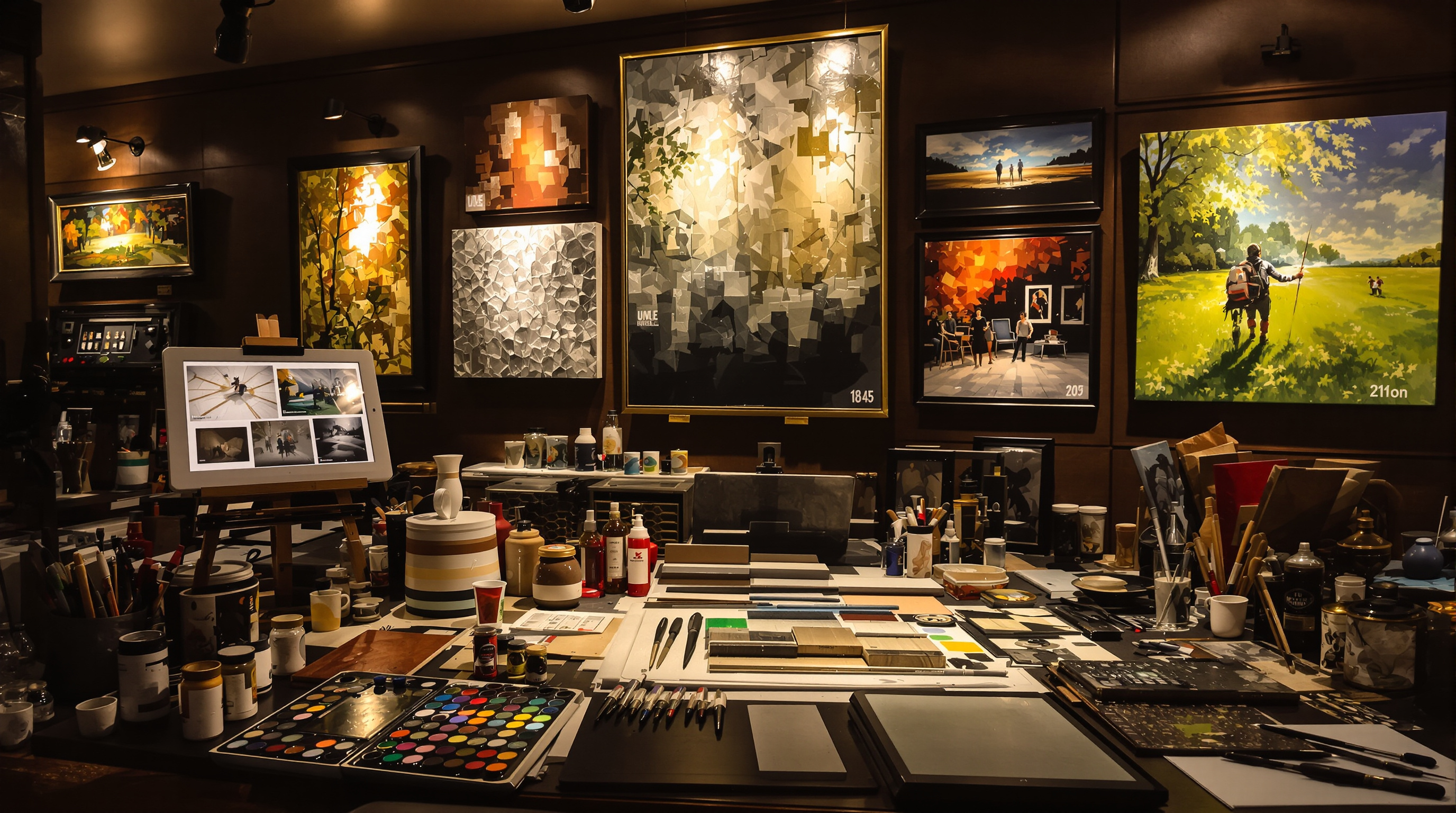The Essential Elements of Fine Art Creation and Presentation
T.K. Broecker / 5 October 2025

The creation of impactful artwork involves mastering multiple interconnected elements that collectively define the visual experience. From the initial choice of medium to the final presentation, each decision influences how viewers perceive and connect with art. Understanding these fundamental components—medium, texture, depth, contrast, finish, presentation, longevity, and professional execution—provides artists with the knowledge to create works that not only capture attention but also stand the test of time.
The Role of Medium in Artistic Expression
The medium an artist selects forms the foundation of their creative process, establishing both possibilities and limitations. Traditional mediums include oils, acrylics, watercolors, charcoal, and pastels, each with distinct properties that influence technique and outcome. Oil paints, dating back to the 15th century, offer rich pigmentation and extended drying times, allowing artists to blend colors and create subtle transitions. Conversely, acrylics provide versatility with quick-drying properties and compatibility with various surfaces.
Digital mediums have revolutionized contemporary art creation, offering unprecedented flexibility through software like Adobe Photoshop, Procreate, and various 3D modeling programs. The medium choice significantly impacts texture capabilities, color vibrancy, and preservation qualities. For instance, watercolors create transparent, luminous effects impossible with opaque mediums, while sculpture mediums like marble, bronze, or wood each convey different sensory experiences through their inherent physical properties.
The medium also carries cultural and historical significance—oil painting’s association with Renaissance masterpieces or digital art’s connection to contemporary innovation. Artists often select mediums that align with their conceptual intentions, technical strengths, and desired visual outcomes.
Creating Visual Interest Through Texture and Depth
Texture introduces tactile qualities to artwork—both actual (physical) and implied (visual). Impasto techniques, where paint is applied thickly, create pronounced textures that catch light and cast microscopic shadows. Collage elements introduce varied surface qualities through materials like fabric, paper, or found objects. Even in digital art, simulated textures add richness through programmed brushstrokes and pattern overlays.
Depth creates the illusion of three-dimensional space on two-dimensional surfaces. Linear perspective, discovered during the Renaissance, uses converging lines to simulate spatial recession. Atmospheric perspective mimics how distant objects appear less distinct and more bluish due to atmospheric particles. Overlapping forms, where foreground objects partially obscure background elements, provides spatial cues about object positioning.
The interplay between texture and depth creates visual complexity that engages viewers. Textural elements in the foreground contrasted with smoother backgrounds enhance spatial perception. In contemporary art, these elements often become conceptual tools—flattened perspective might challenge conventional perception, while exaggerated textures can evoke emotional responses through their tactile associations.
Visual Impact Through Contrast and Finish
Contrast creates visual dynamism through opposing elements. Value contrast—the juxtaposition of light and dark—remains fundamental to creating focal points and directing viewer attention. Color contrasts, including complementary pairings (red/green, blue/orange), create vibrant visual tension. Textural contrast pairs smooth with rough surfaces, while conceptual contrast might juxtapose natural with artificial elements.
The finish of artwork significantly impacts its visual perception and preservation. Varnishes protect painted surfaces while enhancing color saturation—matte finishes reduce glare but soften colors, while glossy finishes increase vibrancy but can create reflections. In photography and digital prints, paper selection dramatically affects the final appearance—high-gloss papers enhance color saturation and detail sharpness, while textured papers add subtle dimension.
Modern finishing techniques include UV-resistant coatings that protect against light damage, resin coatings that create glass-like surfaces, and specialized framing glass that blocks harmful ultraviolet radiation. The finish becomes part of the artwork’s conceptual presence—high-gloss surfaces suggest technological precision, while raw, unfinished edges might emphasize authenticity or process.
Professional Presentation and Ensuring Longevity
Presentation contextualizes artwork and influences viewer experience. Professional framing enhances visual impact while providing physical protection—archival matting prevents acid migration to artwork, while proper mounting techniques prevent warping and deterioration. Installation considerations, including lighting angle and intensity, wall color, and surrounding space, dramatically affect perception. For broader care guidelines and preventive conservation concepts, see the Image Permanence Institute’s resources.
Digital presentation through websites and social media platforms requires additional considerations, including accurate color calibration, appropriate resolution, and contextual information. Professional documentation through high-quality photography preserves the artwork’s appearance for catalogs, archives, and sales platforms.
Longevity concerns have guided artistic practices for centuries. Archival materials—acid-free papers, lightfast pigments, and stable substrates—resist deterioration. Conservation standards recommend controlled environmental conditions (humidity between 40–55% and temperatures between 65–72°F) to prevent deterioration; the Library of Congress preservation portal provides accessible, practical guidelines. Digital preservation presents unique challenges, requiring regular migration to current file formats and storage systems.
The professional approach integrates these elements with consistent artistic vision, technical execution, and business practices. Professional artists maintain documentation of their work, including certificates of authenticity, condition reports, and provenance records. Ethical considerations include proper citation of appropriated elements, transparent communication about materials and processes, and responsible disposal of hazardous art materials. If you need help choosing archival papers, glazing, or mounting methods, contact our team for project-specific recommendations.
Conclusion
In conclusion, creating impactful, enduring artwork requires mastery across multiple dimensions—from the initial medium selection to final presentation decisions. The thoughtful integration of texture, depth, contrast, finish, presentation methods, and preservation strategies elevates artwork beyond mere visual appeal to create experiences that resonate emotionally and intellectually with viewers.
For more display, printing, and preservation tips across photo and art projects, visit our hub at The Print Refinery – Louisville East Blog.